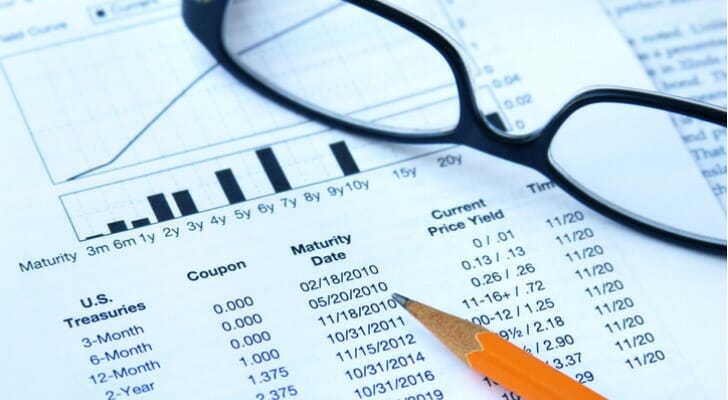A treasury yield represents the return on investment for U.S. government bonds, which are debt securities issued by the U.S. Treasury. Investors buy these bonds, effectively lending money to the government in exchange for a predictable interest payment over time. Treasury yields are influenced by supply and demand in the bond market, and they help indicate broader economic conditions, such as investor confidence and interest rate expectations.
A financial advisor can help assess whether Treasuries and other bonds are a good for your portfolio. Find a fiduciary financial advisor.
Treasury Yields Explained
Treasury yields reflect the returns investors receive from holding U.S. Treasury securities, which come in different forms – Treasury bills, notes and bonds – each with varying maturities. The yield is essentially the interest earned, expressed as a percentage of the bond’s price. For instance, a yield of 3% means the investor earns 3% annually on the bond’s face value.
The U.S. government issues these securities to fund its operations, and investors purchase them as a way to preserve capital with low risk. Treasury yields are calculated based on the bond’s coupon payment relative to its current market price, and these yields often fluctuate because bond prices change in the open market.
Treasury bills or T-bills are short-term securities that mature within one year and have no regular coupon payments, while T-notes pay semi-annual interest and mature in anywhere between two and 10 years. T-bonds also pay interest twice, have the longest durations of these three types of securities, maturing 20 or 30 years after issuance.
Generally, the longer the maturity, the higher the yield, compensating investors for tying up their funds for longer periods.
How Treasury Yields Change
Treasury yields change primarily due to fluctuations in demand for U.S. government bonds and movements in interest rates. When investor demand for Treasury securities is high, their prices increase, which inversely drives yields down. Conversely, when demand decreases, bond prices fall, leading yields to rise. This relationship between price and yield is fundamental to understanding Treasury yields – yields move in the opposite direction of bond prices.
Another key factor influencing Treasury yields is the Federal Reserve’s monetary policy. The Fed sets the federal funds rate, which impacts short-term interest rates and can indirectly influence Treasury yields. For example, when the Fed raises rates to combat inflation, yields on Treasury securities generally rise, as newer bonds are issued with higher coupon rates to match the rising interest rate environment.
Market conditions, such as economic data releases, geopolitical events, and investor sentiment, also contribute to shifts in Treasury yields. Investors may move to the relative safety of government bonds during periods of economic uncertainty, increasing demand and lowering yields. On the other hand, in times of economic growth, investors might seek higher returns elsewhere, leading Treasury yields to rise as prices decline.
Calculating Treasury Yields
The formula for calculating Treasury yields is complicated and changes based on several factors – the bond’s face value, maturity date, purchase price and coupon.
The Federal Reserve Bank of New York notes that yields on Treasury bills require two different methods: The discount yield method and investment yield method. The discount yield formula looks like this:
[(FV – PP)/FV] * [360/M]
In this case FV stands for face value, while PP is purchase price. M is the maturity of the bill, so a six-month Treasury bill would require 182 days. That 360 is the number of days used by banks to determine short-term interest rates. Thus, the discount yield for a 182-day Treasury bill, auctioned at an average price of $9,659.30 per $10,000 face value would be 6.74%.
The investment yield method is based calendar years, so 360 days would be replaced by 365 days or 366 in leap years. Using the same Treasury bill from the example above, the Treasury yield would ab 7.07%.
The formula for bonds and notes is a bit more complex:
[C + ((FV – PP) / M)] ÷ [(FV + PP)/2]
In this formula, the C stands for the coupon rate, while the face value, purchase price and maturity all remain the same. If the Treasury issued a 7-year note with a $100 face value with a 7.875% coupon rate that sold at an average of $99.709, the Treasury yield would be 7.93%.
Why Treasury Yields Matter

Treasury yields can indicate the overall state of the stock market and the general economy. For example, changes in Treasury yields can affect the rise and fall of other interest rates, including mortgage interest rates, auto loans and business loans.
Yields have a see-saw affect on these rates. When the demand for bonds goes up, interest rates tend to go down. And when the demand for bonds goes down, interest rates tend to rise. This happens because an increase in demand will also increase the price and lower the yield and interest rates.
Treasury rates generally signify the level of investor confidence. When confidence in the market is low, buyers tend to gravitate toward safer investments like Treasuries. Thus, the demand for Treasury bonds increases. When investor confidence is high, buyers may take on riskier investments and lower demand for government-backed securities.
You should also note that depending on how yields affect interest rates, borrowing money can become more expensive or cheaper. And this in turn can have a rippling effect on the value of your stock and the rate of return on your investment. So a change in the Treasury yield might be a signal to reassess the fair value of your stock and re-assess the risk of your investment.
Experts have long looked at the 10-year U.S. Treasury yield as a benchmark of the state of the economy.
Bottom Line
While yields represent the return on investment when buying government-backed debt securities such as a Treasury bond, they are important to the financial world for many reasons. They also affect interest rates in other areas of the market, such as mortgage interest rates. And perhaps more importantly, they can be good indicators of the state of the market and investor confidence.
Tips for Investing in Bonds
- A financial advisor can help you invest in bonds and other fixed-income instruments. Finding a financial advisor doesn’t have to be hard. SmartAsset’s free tool matches you with up to three vetted financial advisors who serve your area, and you can have a free introductory call with your advisor matches to decide which one you feel is right for you. If you’re ready to find an advisor who can help you achieve your financial goals, get started now.
- There are other bonds out there that can be sound investments if Treasury bonds aren’t the right fit. The SmartAsset bond buying guide can help you explore other ways to invest in bonds.
Photo credit: ©iStock.com/outline205, ©iStock.com/izusek, ©iStock.com/ipopba
